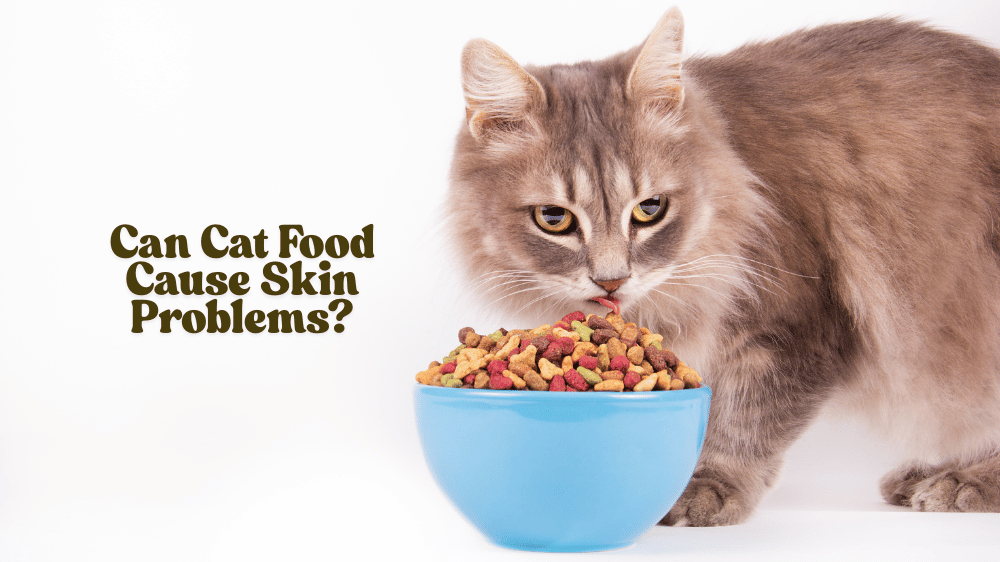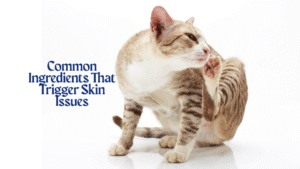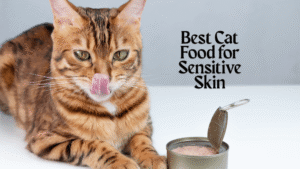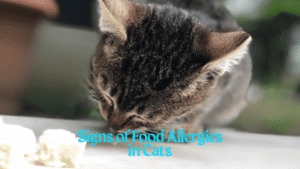“Can cat food cause skin problems?” The short answer is yes, and it’s more common than you might think. As cat owners, it’s important to recognize the link between cat food and skin health. Many cats suffer from various common skin problems in cats that are directly linked to their diet. From dry skin in cats due to diet to severe reactions like itching and rashes, the food you provide plays a crucial role in the health of their skin.
Understanding how cat food can cause skin problems is vital for anyone seeking to prevent or treat these issues. In this post, we’ll dive into how your cat’s diet could be contributing to their skin issues and explore the best cat food for sensitive skin to ensure their comfort and health.
Can Cat Food Cause Skin Problems? The Answer Explained
Yes, cat food can cause skin problems if it has certain allergens in the ingredients or if it is deficient in nutrients. If you’ve been asking yourself, “Can cat food cause skin problem?” —the solution is in understanding how certain ingredients and dietary imbalances can be affecting your cat’s premium skin health.
Common Ingredients That Trigger Skin Issues
So when wondering, “Can cat food cause skin problems?”, you should read the ingredients. Some ingredients in commercial cat food can cause allergic reactions or sensitivities. Common culprits include:
- Cats consuming grains, such as corn, soy, and wheat—these are present in many lower-quality cat foods—may have a hard time digesting them, and experience skin inflammation and itchiness as a result.
- Synthetic preservatives and colorants may act as allergens and cause concomitant dermatological problems.
- For cats with food allergies, individual proteins such as beef, dairy, or fish are also common culprits.
Cats with sensitive systems may develop symptoms like scratching, redness, or hair loss when exposed to these ingredients.
The Role of Nutrition in Skin Health
Then, “can cat food cause skin problems” from poor nutrition? Absolutely. The diet of the cat has a significant effect on the health of the skin and the luster of the coat. Interactions resulting from deficiencies in essential nutrients—omega-3 and omega-6 polyunsaturated fatty acid—in particular may lead to:
- Dry, flaky skin
- Dull or brittle fur
- Increased shedding
- Skin inflammation or irritation
Well-balanced nutrients, such as essential fatty acids, vitamins, and proteins found in high-quality cat food, ensure your cat’s skin is as healthy as possible and minimize the chance any of these diseases will develop.
So, “can cat food cause skin problems?” In conclusion, Yes, especially if it contains allergenic foods or is low in key nutrients. And always be sure to read the ingredient list carefully and talk to your veterinarian if you notice your cat is having skin issues. Transitioning to a hypoallergenic or high-protein food can often help with these issues, ultimately providing enormous relief for your cat.
Common Skin Problems in Cats Due to Diet
That begs the question, “Can cat food cause skin problems? We need to give value to the fact that a cat’s skin’s health is highly influenced by its diet. Poor-quality utensils or nutrient imbalances for cat food are often the cause for most of the normal skin conditions of cats. The following are 8 of the most common skin conditions in cats that are associated with diet:
1. Dry Skin
“Can cat food cause skin problems” such as dryness? Absolutely. Dry, flaky skin is one of the most common signs of poor nutrition. This is commonly found when the diet is deficient in essential fatty acids like omega-3 and omega-6 that help to support the moisture barrier of the skin.’ Cats with flaky skin can feel itchy and uncomfortable. Switching to a higher-nutrient, better-balanced diet can help to hydrate skin and keep it that way.
2. Itching and Inflammation
Curious if cat food can make the cat itchy? Yes — one of the top culprits is food allergies. Cat allergens include ingredients such as: beef, fish, dairy, soy, or wheat. If a cat eats something it is allergic to, it can initiate the immune system, which in turn releases histamines that cause severe itchiness and redness. Your little guy’s constant scratching only makes the situation worse: Scratching can lead to sores or an infected rash. So when you ask, “Can cat food cause skin problems?” allergies are of paramount interest.
3. Hot Spots and Rashes
Hot spots and rashes are painful, focal, red, oozing, or crusted lesions of the skin. “Can cat food cause skin conditions” similar to these?” Yes, especially if there are ingredients in the food your cat is allergic to or sensitive to. A poor diet weakens the immune system, leaving the skin susceptible to flare-ups and infections. Sometimes the solution to this problem lies in finding and eliminating the allergen from the diet.
4. Excessive Shedding and Hair Loss
Another response to “Can cat food cause skin issues?” is “excessive shedding”. A coat that’s more brittle than normal may indicate nutritional imbalances, particularly regarding protein, vitamins, or fatty acids. Furthermore, cat food causing itching’ results in increased grooming which in turn causes hair loss and thinning fur’. A skin-friendly, coat-promoting diet can go a long way towards alleviating these symptoms.
5. Skin Infections
Nutritionally deficient diet increases likelihood of cats having a bacterial or fungal skin infection. Why? Because malnutrition weakens the immune system, making it more difficult for the body to fight off pathogens.
🐾 Best Cat Food for Sensitive Skin: What to Look For
“Can cat food cause skin problems?” Yes — and choosing the right diet is one of the most effective ways to prevent and manage skin conditions in cats caused by food. If your feline friend is suffering from dry skin, itching, or excessive shedding, it may be time to evaluate their nutrition.
Below are key features to look for when selecting the best cat food for sensitive skin, along with guidance on how to support cat skin health through diet.
1. 🐟 Hypoallergenic Cat Food
If you’re noticing signs of food allergies in cats — such as scratching, redness, or skin inflammation — switching to a hypoallergenic cat food formula is highly recommended. These specialized diets are designed to eliminate common allergens like beef, fish, dairy, and grains.
- Why it helps: Hypoallergenic formulas reduce immune reactions that lead to cat food causing itching and rashes.
- Best for: Cats experiencing common skin problems like hot spots, hair loss, or chronic inflammation.
2. 🧴 Essential Fatty Acids for Skin Nourishment
An important factor in addressing dry skin in cats due to diet is ensuring the food contains omega-3 and omega-6 fatty acids. These essential nutrients help moisturize the skin, reduce inflammation, and support a glossy, healthy coat.
- Why it helps: Fatty acids are crucial for overall cat skin health and diet balance. They are especially effective in relieving dryness and restoring the skin barrier.
- Tip: Look for cat food with salmon oil, flaxseed, or fish meal as a source of omega fatty acids.
3. 🌾 Grain-Free Formulas
“Can cat food cause skin problems” due to grains? For some cats, yes. Grains like corn, wheat, and soy are frequent allergens that contribute to skin conditions in cats caused by food. A grain-free diet can be a gentler, less inflammatory option.
- Why it helps: Reduces the risk of allergic reactions and supports digestion and nutrient absorption.
- Best for: Cats with sensitive stomachs or recurring itching and irritation.
4. 🐔 Limited Ingredient Diets (LID)
Limited ingredient diets simplify your cat’s meals by minimizing the number of ingredients. This makes it easier to identify potential allergens and eliminate them from your cat’s diet.
- Why it helps: Ideal for isolating and managing skin problems caused by food.
- Tip: Choose LID options that include a single animal protein (like turkey or rabbit) and one carbohydrate source (like peas or sweet potato).
5. ✅ High-Quality, Natural Ingredients
When exploring how to prevent skin problems in cats, always prioritize high-quality cat food with clearly named animal proteins as the first ingredient. Avoid foods loaded with artificial colors, preservatives, or by-products.
- Why it helps: Low-quality ingredients often trigger cat food causing itching, poor coat condition, and excessive shedding.
- Look for: Labels that list whole meat (e.g., chicken, salmon) and contain no synthetic fillers.
🔍 Final Thoughts: Can Cat Food Cause Skin Problems?
Yes — and it often does when the food includes allergens, lacks essential nutrients, or contains low-quality ingredients. By choosing the best cat food for sensitive skin, you can significantly reduce symptoms like itching, dry skin, and inflammation.
🛡️ To Support Your Cat’s Skin Health:
- Choose hypoallergenic, grain-free, or limited ingredient diets.
- Ensure adequate intake of omega fatty acids for optimal skin and coat health.
- Monitor for signs of food allergies in cats, such as scratching, hair loss, or skin rashes.
With the right dietary approach, you can dramatically improve your cat’s comfort and reduce the risk of future skin conditions in cats caused by food.
🛡️ How to Prevent Skin Problems in Cats Caused by Food
“Can cat food cause skin problems?” Yes — but the good news is, many of these issues are preventable with the right approach to nutrition and care. If your cat is prone to itching, hair loss, or flaky skin, here’s how to prevent skin problems in cats caused by dietary triggers:
1. 🧪 Identify Food Allergies Early
One of the most effective ways to prevent skin conditions in cats caused by food is to recognize and address signs of food allergies in cats early. Watch for symptoms like:
- Persistent itching
- Red or inflamed skin
- Frequent grooming
- Bald patches or hair loss
If you suspect an allergy, consult your vet for diagnostic testing. Once allergens such as beef, fish, grains, or dairy are identified, eliminate them from your cat’s diet to reduce flare-ups.
2. 🥣 Transition to New Foods Gradually
When changing your cat’s food, avoid abrupt transitions. A sudden diet change can stress their digestive system and trigger skin problems, especially if the new food contains an unnoticed allergen.
- Mix the new food with the current one over 7–10 days.
- Gradually increase the proportion of new food.
- Monitor for any skin reactions or gastrointestinal issues.
This helps you safely introduce better cat food for sensitive skin while minimizing the risk of flare-ups.
3. 👀 Monitor Skin and Coat Health Regularly
Tracking your cat’s skin condition is vital. After any dietary adjustments, observe for changes such as:
- Reduction in scratching or itching
- Improvement in coat texture or shine
- Healing of any rashes or hot spots
By identifying patterns, you can determine which foods support cat skin health and diet best — and which ones should be avoided.
4. 🩺 Schedule Regular Vet Check-Ups
Preventive care plays a major role in how to prevent skin problems in cats. Your vet can:
- Spot early signs of skin problems in cats
- Suggest tailored nutritional plans
- Recommend hypoallergenic cat food if needed
Routine checkups help ensure skin conditions are detected and managed before they become severe.
5. 🐾 Feed a Balanced, Nutrient-Rich Diet
A complete and balanced diet is your cat’s first defense against skin conditions caused by food. Look for cat foods that:
- Contain high-quality animal protein as the first ingredient
- Include omega-3 and omega-6 fatty acids for moisture and inflammation control
- Are free from artificial preservatives, dyes, and fillers
A nutrient-dense diet helps maintain a shiny coat, strong immunity, and healthy, irritation-free skin.
✅ Final Note
So, “can cat food cause skin problems?” Yes — but with proactive care, dietary awareness, and the right feeding strategy, you can prevent skin problems in cats and ensure they thrive with healthy, comfortable skin.
By staying informed and attentive to your cat’s dietary needs, you’re not just feeding them — you’re protecting their health, from the inside out.
Table: Common Skin Problems in Cats and Their Dietary Causes
| Skin Problem | Possible Cause | Suggested Action |
| Dry, flaky skin |
Lack of essential fatty acids in food |
Choose food rich in omega-3 and omega-6 fatty acids to improve skin health |
| Itchy skin (pruritus) |
Food allergies (proteins like beef or fish) |
Switch to hypoallergenic cat food or a limited ingredient diet |
| Hot spots |
Grains, preservatives, or certain proteins |
Try a grain-free, preservative-free cat food to prevent irritation |
| Excessive shedding |
Poor nutrition or imbalanced diet |
Provide food with balanced nutrients and essential fatty acids |
| Rashes and infections |
Poor immune function from unbalanced diet |
Consult a vet and switch to a higher-quality, nutrient-rich food |
🚨 Signs of Food Allergies in Cats: How They Relate to Skin Problems
“Can cat food cause skin problems?” In many cases, yes. Recognizing the symptoms early is key to preventing discomfort and long-term skin issues in your feline friend.
Here’s what to look out for and how food allergies directly impact cat skin health and diet:
1. 🔍 Recognizing the Signs of Food Allergies in Cats
Understanding the signs of food allergies in cats can help you quickly take action. The most common symptoms include:
- Persistent itching or scratching
- Red, inflamed skin
- Excessive grooming
- Hair loss or bald patches
- Recurring ear infections or skin infections
These signs often point to a reaction triggered by certain ingredients in your cat’s diet, directly answering the question: “Can cat food cause skin problems?” Yes, particularly when allergens are involved.
2. 🧫 Common Food Allergens in Cat Diets
The following ingredients are among the most frequent culprits in skin conditions in cats caused by food:
- Dairy products
- Beef
- Fish
- Grains (such as corn, wheat, and soy)
For cats with sensitive skin, these ingredients may cause cat food causing itching, rashes, and other inflammatory skin responses.
📌 Solution: Consider switching to a hypoallergenic cat food that eliminates common allergens and uses novel protein sources (like duck or venison) or hydrolyzed proteins that reduce the risk of allergic reactions.
3. 🩺 When to Consult a Veterinarian
If your cat’s skin issues persist despite dietary changes, it’s essential to seek veterinary guidance. A vet can:
- Evaluate if the symptoms are indeed food-related
- Rule out environmental or flea allergies
- Recommend a therapeutic diet suited for sensitive skin
They may also suggest further diagnostics or a food elimination trial to narrow down the allergen.
4. 🔬 Testing for Food Allergies
“Can cat food cause skin problems” that persist even after diet changes? Yes — especially if the exact allergen isn’t identified. That’s where allergy testing becomes invaluable.
- Blood tests or intradermal testing can help identify food sensitivities.
- Elimination diets are commonly used, where cats are fed a simple, limited-ingredient diet and gradually tested for reactions.
Once the offending ingredient is pinpointed, you can confidently choose a diet that promotes long-term cat skin health and diet balance — free from triggers that cause flare-ups.
✅ Final Thoughts
If you’re wondering, “Can cat food cause skin problems?”, the answer is a clear yes — especially when food allergies go unnoticed. Being proactive about recognizing symptoms and addressing dietary triggers is crucial to preventing further discomfort.
By identifying allergens, choosing the right hypoallergenic cat food, and working with your vet, you can significantly reduce skin conditions in cats caused by food and improve your cat’s quality of life.
🐱 Cat Skin Health and Diet: Maintaining a Balanced Diet for Optimal Skin
Many pet owners ask, “Can cat food cause skin problems?”. The quality and composition of your cat’s diet have a direct impact on their skin’s health and overall wellbeing. Understanding the relationship between cat skin health and diet is essential to prevent and manage skin issues caused by food.
1. 🥗 The Role of Diet in Preventing Skin Problems
When considering, “can cat food cause skin problems”, it’s important to recognize that a balanced diet rich in essential nutrients, particularly omega-3 and omega-6 fatty acids, is crucial for maintaining healthy skin. Without these fatty acids, cats may develop dry skin in cats due to diet, leading to flaky, irritated, or inflamed skin.
- These fatty acids help strengthen the skin barrier and reduce inflammation, which is often the root cause of skin conditions in cats caused by food.
- Ensuring your cat’s diet includes these nutrients is a proactive way to answer “can cat food cause skin problems?” with prevention.
2. 🥇 Selecting the Best Cat Food to Support Skin Health
To address the question, “can cat food cause skin problems?” Choosing the best cat food for sensitive skin is vital. Look for:
- High-quality animal proteins and natural sources of fatty acids such as fish oil.
- Grain-free or hypoallergenic cat food options, which eliminate common allergens like grains, beef, or dairy that often trigger cat food causing itching and other skin irritations.
Feeding your cat a carefully selected diet reduces the risk of food-related skin issues and promotes a healthy, vibrant coat.
3. 💊 Supplements to Enhance Skin Health and Comfort
If you’re wondering “can cat food cause skin problems” even with a balanced diet, sometimes supplementation helps fill nutritional gaps. Adding supplements like fish oil or biotin can significantly improve your cat’s skin condition by:
- Enhancing skin hydration
- Promoting a shiny coat
- Minimizing itching and irritation linked to diet-induced skin problems
Always consult your vet before introducing supplements to ensure they complement your cat’s unique dietary needs safely.
So, “can cat food cause skin problems?” Absolutely. But by understanding the crucial role of diet in cat skin health and diet, and by selecting nutrient-rich, hypoallergenic foods along with appropriate supplements, you can effectively prevent and manage skin problems caused by food. This approach ensures your cat maintains a healthy, comfortable, and beautifully glowing coat.
🐾 Can Switching Cat Food Help Improve Skin Problems?
If you’ve been asking, “can cat food cause skin problems?” the answer is a clear yes but there is always a solution. Fortunately, switching to a better-quality or specialized diet can often lead to noticeable improvements in your cat’s skin health. Here’s why and how changing your cat’s food can make a real difference:
1. 🌟 Why Switching Food Matters
Many skin problems in cats are triggered by allergies or sensitivities to certain ingredients in their current diet. By switching to a more suitable option—such as hypoallergenic cat food—you can reduce inflammation, itching, and other discomforts caused by cat food causing itching or irritation.
- High-quality, limited-ingredient diets help avoid common allergens like beef, fish, or grains.
- Specialized formulas support healthier skin by providing essential nutrients like omega fatty acids.
2. 🔄 Gradual Diet Transition Is Key
When switching your cat’s food, avoid sudden changes that could upset their digestive system. Gradual transitions allow your cat’s gut to adjust smoothly and help prevent additional skin flare-ups linked to digestive stress.
- Start by mixing a small portion of the new food with the old.
- Over 7–10 days, slowly increase the amount of new food until the switch is complete.
- Monitor your cat closely for any adverse reactions during this transition.
3. ⏳ How Long Until You See Improvements?
Improvements in skin health after changing food can vary. Some cats show positive changes within a few days, while others may take several weeks.
- Keep an eye on symptoms like dry skin in cats due to diet, itching, redness, or rashes.
- If no noticeable improvement occurs after a few weeks, or if symptoms worsen, consult your veterinarian.
- Your vet can help identify underlying issues or recommend a tailored diet plan.
So, if you’re wondering “can cat food cause skin problems?”, remember that switching to the right food can be a powerful step toward relief. With patience and the right diet, you can support your cat’s skin health and overall well being effectively.
Conclusion
Understanding “can cat food cause skin problems” is essential for every cat owner. By choosing the right food and understanding how diet impacts skin health, you can help prevent common skin problems like itching, dryness, and shedding. If your cat is showing signs of food allergies or skin issues, consult your vet and make informed decisions to ensure their well-being. Adopt a proactive approach to your cat’s diet, and keep their skin healthy and glowing!
Ready to make the switch? If you suspect that your cat’s skin issues are caused by their food, it’s time to try a new diet. Explore hypoallergenic cat food or grain-free options that are designed to support sensitive skin. Consult with your vet and start making dietary changes today to help your cat enjoy better skin health and a happier life!
Frequently Asked Questions (FAQs)
Q1: Are there specific ingredients in cat food that can lead to skin issues?
You read that right, “can cat food cause skin problems?” Absolutely. One of the most common triggers is grains, but also dairy and certain meat proteins (like beef or fish) can create allergic response to cats which ultimately result in skin problems such as itching, redness, and inflammation.
Q2: What’s the top cat food for sensitive skin?
Hypoallergenic cat food and grain-free diets that contain omega 3 fatty acids is strongly recommended for cats with skin issues. These choices lower the chances of allergy sensitivity and naturally promote stronger, more supple skin.
Q3: How do I determine if someone’s cat has food-related skin issues?
Symptoms like continuous itching, losing hair, dry skin, and rashes are usually the typical cues of food-related skin issues. Tracking your cat’s diet and paying close attention to skin changes can assist in isolating potential culprits of cat skin problems.
A4: Can poor diet cause cats to shed?
Yes. An unbalanced diet that is deprived of essential nutrients and may not supply the healthy fats your pet needs can lead to more shedding and a dull hair coat. Providing a high quality diet for your cat is essential to keeping a lustrous fur coat and controlling shedding.
Q5: When is it time to consult a vet on my cat’s skin problems?
If your cat’s skin issues persist even after you’ve adjusted his or her diet, or if there are signs of infection, speak with a veterinarian. The nail tech can diagnose the cause and recommend treatments or a change in diet.








